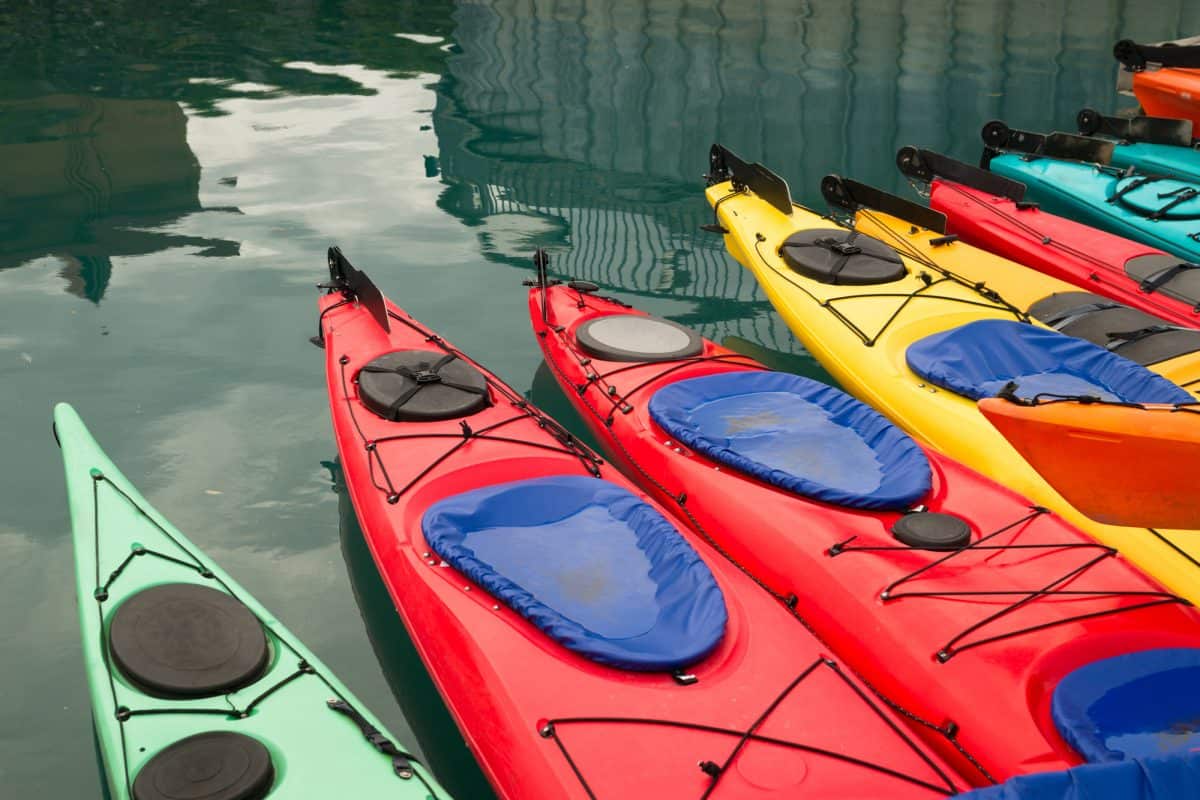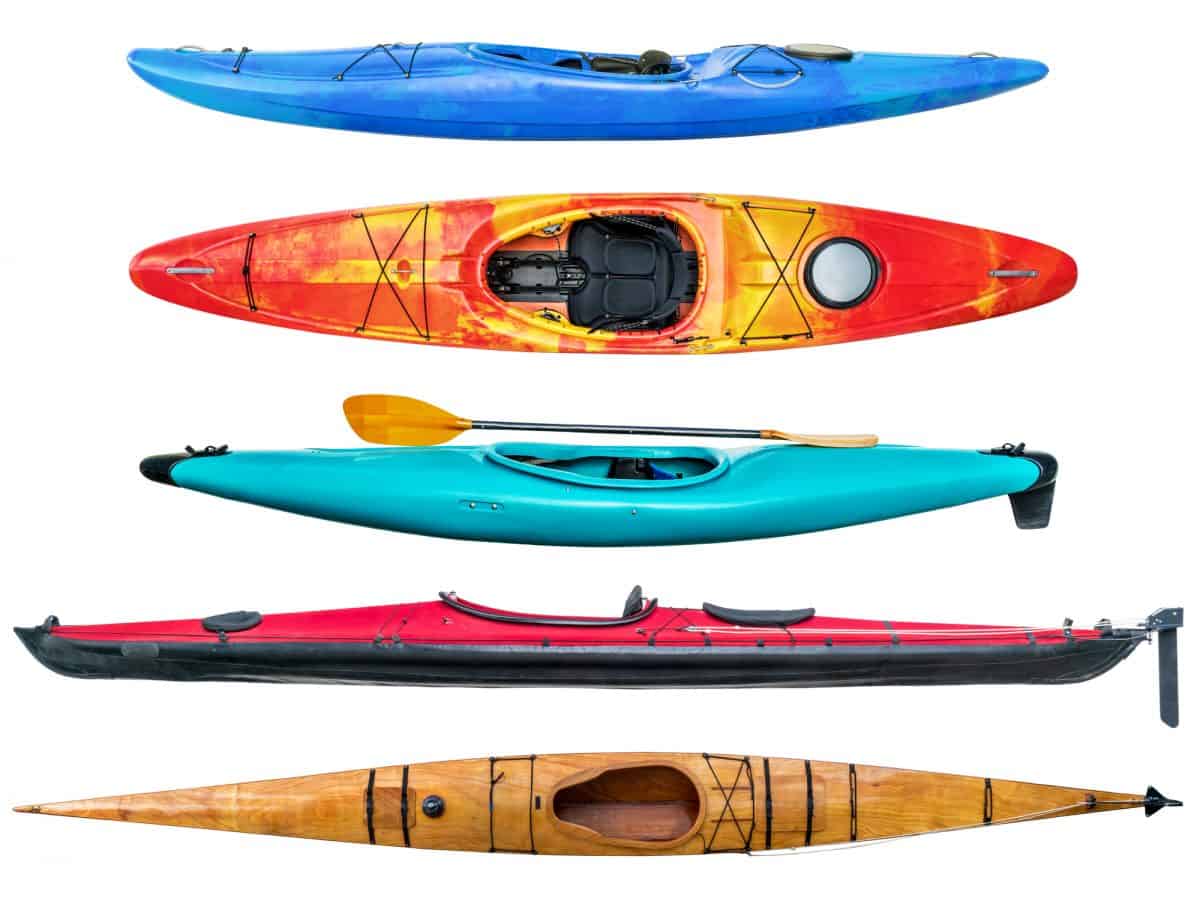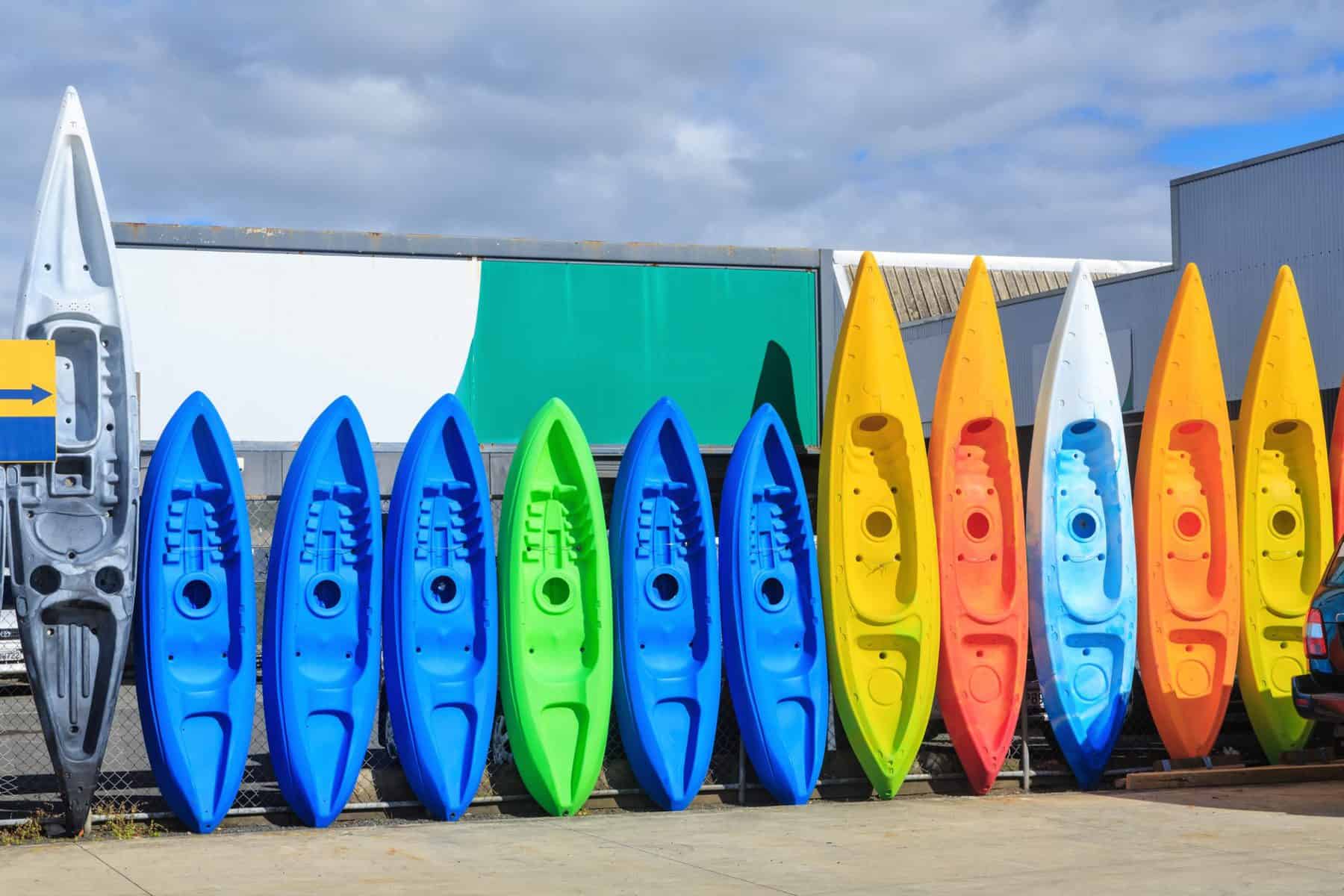Kayaks are typically made from materials such as polyethylene, composites (fiberglass, carbon fiber, or Aramid fiber), wood, and inflatable materials (PVC, Hypalon, Nitrylon).
The materials used in a kayak’s construction and the manufacturing processes contribute to its performance, durability, weight, price tag, and, last but not least, attractiveness.
So, if you’re in the market for a new kayak, the first question you should be asking is: What are kayaks made of, and how do you decide on the right kayak material for your needs?
In this guide, we’ll break down the science behind the different materials kayaks are built from and help you understand the advantages and disadvantages of each. We’ll cover:
- The history of kayak construction, from the Inuit’s traditional wooden kayaks to modern-day materials
- The different types of kayak materials used today, including wood, polyethylene, composites (fiberglass, carbon fiber, and Aramid fiber), and inflatable materials
- The pros and cons of each material, considering factors such as durability, weight, performance, and cost
- How to choose the right material based on your specific needs, preferences, and budget
By the end of this article, you’ll have a clearer understanding of the various materials available and be better equipped to make an informed decision when selecting your next kayak.
Key Takeaways
- Kayaks can be made from various materials, each with its own advantages and disadvantages in terms of performance, durability, weight, and cost.
- Traditional kayaks were made from wood, which is lightweight, durable, and allows for unique designs. However, wooden kayaks are labor-intensive and expensive unless you build one yourself.
- Rotomolded polyethylene is the most common and affordable kayak material. It’s durable, UV-resistant, and low-maintenance, but heavier and less efficient than other materials.
- Thermoformed ABS is lighter and stiffer than rotomolded polyethylene, offering better performance at a slightly higher cost. It’s a good middle ground between polyethylene and composite kayaks.
- Composite kayaks, made from fiberglass, carbon fiber, or Aramid fiber, are the lightest and most efficient option. They offer superior performance and customization but are more expensive and less durable than plastic kayaks.
- Inflatable kayaks, made from PVC or Hypalon, are highly portable and easy to store. They offer a good balance of durability, performance, and affordability, making them a popular choice for recreational paddlers.
- When choosing a kayak material, consider your budget, intended use, and desired performance characteristics to find the best option for your needs.
The Different Types Of Kayak Materials Used In Kayak Construction: What Are Kayaks Made Of?

Your kayak is thousands of years old. I mean, not your brand-new sit-inside ocean kayak per se – but the actual design and idea behind it.
You see, the Inuit, indigenous people of the Arctic regions, were the first ones to build kayaks as we know them today – more than 2000 years ago. These primitive boats were made of sealskin stretched over wooden or whalebone frames and used for fishing, hunt, and travel.
We’ve borrowed a lot from original Inuit kayaks, adapting them to today’s paddlers’ needs by employing new materials and construction techniques.
I’m glad to report that, as far as modern-day kayak materials and construction methods go, sealskin and whalebone are no longer on the list – but the following materials are!
And each has their own pros and cons – lets me explain by material type.
Wooden Kayaks
You won’t find many off-the-shelf wood kayaks – they are the furthest possible thing from “mass-produced” that today’s kayaks can be.
They’re generally products of manual labor, craftsmanship, and do-it-yourself projects and lend themselves to two common construction styles:
- Strip-built or cold-molded wooden kayaks, which are made by binding strips of wood together around temporary frames, and allow for endless design possibilities
- Stitch-and-glue method, which doesn’t require advanced woodworking skills, but you have to cut plywood into desired shapes, stitch the pieces together with wire, and then glue everything – hence the name
Once assembled, the wood is coated with defensive layers of fiberglass and resin and then typically covered with a varnish finish This is to protect the wood by preventing warping and minimize the not-so-gentle effects of water damage.
Wood as a kayak material is noted for its beauty, lightweight-but-durable nature, endless design options, and relatively low cost, provided that you make one yourself.
Otherwise, they’re going to cost you – a lot.
Advantages
- Kayaks made of wood are traditional-looking, stunning, and unique
- Structurally efficient, lightweight, and robust as their composite counterparts
- DIY enthusiasts and woodworkers will love the freedom of designing their kayak
- You can make a composite-quality kayak at a relatively low cost
Disadvantages
- It takes a lot of time and woodworking skills to make one yourself
- Buying one can cost you more than a composite kayak
- Not the best choice for rocky, whitewater environments
- Difficult to incorporate flotation devices and sealed bulk-heads.
Rotomolded Kayaks
Rotomolded polyethylene is, hands down, the most commonly used kayak material – at least in the world of recreational kayaking, anyway. And it’s been that way ever since the 1970s when Perception Kayaks first introduced rotomolded kayaks.
The term “rotational molding” refers to the process of making these plastic’ yaks:
Rotomolded kayak manufacturers use plastic pellets poured into the mold, heated, and rotated in a huge “oven” until the melted polyethylene coats the inside of the mold evenly. The result is a one-piece kayak that’s immediately ready to be outfitted and launched into the water.
It’s a straightforward process that doesn’t involve layering materials or fusing separate parts, explaining the inexpensive nature of rotomolded PE kayaks.
Besides the budget-friendly price, the so-called “Tupperware” kayaks are also favored for their impact-resistance. Polyethylene plastic hulls have some flex to them, meaning they’re more likely to bend than to break.
That’s why they’re often used in whitewater and rocky environments – although the extra weight means they’re less than ideal choices for long-distance touring and speed.
Advantages
- One-piece PE kayaks are pretty much water-ready straight out of the mold
- Polyethylene’s flexibility ensures impact-resistance
- The most inexpensive kayak material as far as hard-shells go
- Suitable for whitewater and rocky environments
Disadvantages
- Heavy compared to other kayak materials
- Susceptible to UV damage and require protective coatings
- Tend to “oil can” due to heat exposure
- Punctures can be difficult to repair
- Makes for less responsive kayaks
Thermoform Kayaks
You can view these kayaks as a compromise between polyethylene and composite kayaks.
Thermoformed kayaks offer superior performance, use higher-quality plastic, and are generally more durable and long-lasting than rotomolded ones. Still, they’re nearly as lightweight as composite kayaks.
Their price reflects that middle-of-the-road status, too:
Given that it’s more expensive than polyethylene – but still less expensive than composite construction – thermoform ABS stands out as the go-to kayak material for making mid-range models.
Thermoforming is a relatively new manufacturing process – and while it uses plastic as the main component, it’s not to be confused with rotomolded polyethylene kayaks:
It involves fusing several plastic layers, with impact-resistant ABS plastic as the base layer and one or more outer acrylic layers, to form a multi-layered plastic sheet. The sheet is heated and stretched over the existing mold using the vacuum.
The kayak’s hull and deck are thermoformed separately before getting trimmed, assembled, and “detailed.”
Advantages
- More durable and scratch-resistant than polyethylene kayaks
- Nearly as lightweight as composite kayaks, but at a fraction of the cost
- Outer layers provide UV resistance and give thermoformed kayaks a glossy finish
- Easier to repair
Disadvantages
- Thermoform ABS degrades over time even with proper maintenance
- This kayak material is generally recyclable
Composite Kayaks
Kayaks made of fiberglass, carbon fiber, or Aramid fiber – and, in some cases, a blend of all three – are all a variation of layered synthetic fabric construction.
So, when you see the word “composite,” remember that it’s an all-inclusive term that covers:
- Fiberglass, or glass-reinforced polymer, the tried-and-true granddaddy of composite materials. A fiberglass kayak is up to 20% lighter than a polyethylene yak and a popular choice with those into sea kayaking
- Aramid fiber, also known under the name Kevlar, has similar properties as fiberglass but is typically lighter and more expensive
- Carbon fiber, which is the most lightweight composite kayak material but still highly rigid – and costly – and is often used for making high-end sport, racing and touring kayaks
These fabrics are layered and bonded by resin – usually with cores inserted into the laminate for rigidity – applied to a gel-coated mold, and vacuum-sealed. The kayak’s deck and hull are made separately before being fused into the final product using fiberglass tape and epoxy resin.
They’re glossy, attractive, and oh-so-sleek. Seriously, when it comes to good looks, plastic ‘yaks don’t stand a chance standing side-by-side with composite kayaks.
Looks aside, composite kayaks are known for being ultra-lightweight, fast, and responsive. The materials are stiffer than plastic, which further improves the kayak’s overall performance and ensures better tracking.
Advantages
- Ultra-lightweight construction with an excellent strength-to-weight ratio
- The stiffness of composite materials makes for responsive kayaks
- Unmatched performance, tracking, and efficiency
- Less susceptible to UV damage
- Scratches, cracks, and punctures can be repaired with minimal tools
- Suitable for making sea kayaks and touring kayaks
Disadvantages
- Most expensive kayak material for hard-shells
- Sharp, direct hits can cause severe hull damage
Inflatable Kayaks
The materials used for making inflatable kayaks are softer and rubber-like.
They’re meant to withstand high inflation pressures and allow for deflating and folding the kayak when it’s not in use – something you can’t do with a plastic or composite hull.
For those of you wondering what inflatable kayaks are made of, the three most commonly used materials are:
- PVC – Polyvinyl chloride, which also goes under the name vinyl – or PVC, for short – holds the title of the most popular kayak material when it comes to inflatables. It’s inexpensive, relatively lightweight, and can be bonded to other materials, such as nylon, for improved strength and tear-resistance. However, it’s sensitive to UV damage and high temperatures, and it’s also bad for the environment.
- Hypalon – The synthetic rubber patented by DuPont is a high-performance material noted for its ruggedness, resistance to UV radiation, mildew, abrasion, and extreme temperatures. The most advanced kayak material of the three is generally reserved for high-end inflatable kayaks, hence the higher-than-average price.
- Nitrylon – Manufacturers of inflatable kayaks are starting to look into more eco-friendly PVC alternatives, such as Nitrylon. The lamination of synthetic nitrile rubber and the 1200-denier polyester fabric has shown to be much more abrasion- and puncture-resistant and more reliable than PVC. But since it’s relatively heavy, it’s mostly found on the sides and bottom of inflatable kayaks.
Advantages
- Kayaks made from these materials are lightweight and relatively cheap
- Easy to repair and patch up smaller punctures with repair kits
- Soft, rubber-like materials can be folded when needed, maximizing convenience and portability
Disadvantages
- Susceptible to punctures and UV damage
- Sensitive to extreme temperatures and direct sun exposure
- PVC is not an eco-friendly material
- Folding kayaks are prone to developing mold and mildew
Comparison Of Commonly Used Kayak Materials

Plastic Vs. Composite Kayaks
You – like most beginner paddlers – probably want to know are fiberglass kayaks better than plastic. Are the advancements in construction quality, kayak material, and performance enough to justify the not-so-subtle difference in kayak price?
Well, yes – and also, no.
Although heavier, a plastic kayak is much more affordable and impact-resistant, making them the preferred choice of novice kayakers. Most sit-on-top and recreational ‘yaks on today’s market are made of rotomolded polyethylene.
The main advantages of composite kayaks are the lightweight and highly efficient hull designs and hard-to-beat performance.
But unless you’re highly experienced and plan on doing long-distance touring, stick with plastic. Why spend thousands on a composite kayak if you won’t use it to its full potential?
Thermoformed Vs. Rotomolded Kayaks
Both thermoform and rotomolded kayaks are, in essence, made of plastic – but again, there’s a significant difference in the manufacturing process. And that impacts the actual design, weight, durability, and performance of these plastic kayaks, too.
On the one hand, you have rotomolded kayaks – the most common and least expensive hard-shell kayaks. If you’re sticking to a specific budget and don’t mind the extra weight, PE or “Tupperware” kayaks are a pretty solid choice.
And on the other hand, you have kayaks made of thermoformed ABS. They’re significantly lighter, UV-resistant, and closer to composite kayaks performance-wise but still retain a reasonable, mid-range price.
It’s easy to see why thermoform kayaks are deemed the superior choice. However, the answer to what kayak material is better comes down to what works for you.
What’s The Best Material For A Kayak?

There’s no such thing as the best kayak material.
The end.
All jokes aside, it’s hard to give a definitive answer to a question like that.
Each kayak material has its strengths and weaknesses. You have to consider how these will add to – or take away from – the kayaking experience.
My advice would be to test the waters with a rotomolded polyethylene kayak and go from there.
It’s the least expensive option, it gets the job done – and it’s far more resilient than you think!
If you still can’t decide on the “best” kayak material, consider where, when, and how often you’ll be kayaking, what’s the acceptable kayak size and weight – and set a budget.
Once you’ve got your answers, go over the most common kayak materials again and see which one meets your expectations.
Quick Summary: What Are Kayaks Made Of?
I hope this helps you understand what each kayak material and manufacturing process brings to the table.
Kayaks have come a long way from sealskin and whalebone, that’s for sure. When it comes to modern-day ‘yaks, your options come down to:
- Wooden kayaks, which are more traditional-looking and are usually hand-crafted using stitch-and-glue or strip-built methods
- Rotomolded polyethylene kayaks, which are the cheapest and most widely used kayaks toda – an obvious choice for beginners
- Thermoform ABS, a step-up from polyethylene material that’s lighter, durable, UV-resistant, and offers superior all-around performance
- Composite materials, including fiberglass, Kevlar, and carbon fiber, make for lightweight, fast, responsive high-end kayak
- Inflatable kayaks, which are made of softer, rubber-like materials, most commonly PVC, Hypalon, and Nitrylon




